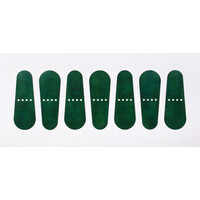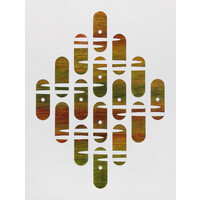Artists
Work History
Artist Information
Russell Moses is a senior New Zealand artist whose career spanning over 40 years has been profoundly shaped by the elemental aspects of the natural landscape.
“Moses has a special notion of landscape. It is not landscape in the sense of being view or vista, but the evocation, memory and record of a particular place. The artist is deeply interested in history and dedicated to mimicking the organic processes at play in nature. His are the patterns visible in the surface of the earth. Moses engages in a repetitive process of deconstruction and construction, finding a detail, cropping it and reconfiguring it to produce works and series that grow out of each other over time.” 1
For the past two decades, Moses has primarily worked with recycled metals and paint mediums, creating wall installations that use abstraction and symbolism to tell the stories of the land. Groups of carefully ordered shapes reference the tools of topography and surveying, which divide the landscape into discrete, quantifiable segments. Painted and printed surfaces evoke crystalline structures, ripples of water, fractured light, leaves, and the patterns left on the land by human intervention.
"Moses’ compositions also draw on sound—the beats, rhythms, and pulse of life visually rendered.” 2 The illusion of sound emerges through the rhythmic repetition of colour, texture, and form. Light dances across the surface, creating fleeting impressions that accentuate contrasts of light and dark, negative and positive, presence and absence. These shifting elements construct a visual ground that is always in flux, unifying his wall works through a dynamic sense of harmony.
In the late 1960s and early 1970s Moses worked in demolition yards in Auckland and then Dunedin, which provided ample opportunity for creative experimentation with recycled materials. This in turn led to a friendship with Ralph Hotere, who would collect demolition doors and windows for his Observation Point studio in Port Chalmers.
Over the decades, Moses has worked with a variety of materials including clay, wood, stone, and steel. His early, large-scale ceramic works were pit-fired at the back of Hotere’s studio and in the 1980s he fought alongside the artist and other Port Chalmers’ residents to save the point from Port Otago's expansion project. Moses’ Headland (1996) is a lamentation for the destruction of the site; created from the clay of the demolished headland, the artist weaves together medium, form, and narrative to create a work that expresses both personal and universal truths.
This is also seen in Moses’ site-specific sculptures, one of which, Waka, can still be seen at Port Chalmers’ Back Beach. As the artworks weather and erode away, they reflect both physical and temporal place, and invite contemplation of the inexorable processes of the natural world. Situated in the land and created of the land, they remind us too that we are of the earth and are bound by its rhythms.
Moses has exhibited nationally and internationally, and his works are held in a number of public collections in New Zealand. It is perhaps most fitting however, that his artworks can also be found in the land itself, slowly returning to their source and visible reminders of the intimate relationship between artist and his environment.
Solo Exhibitions
Group Exhibitions
- 2026 - The Whakatipu Chronicle
- 2025 - Currents
- 2025 - Illumination
- 2025 - Taonga
- 2025 - Aotearoa Art Fair
- 2025 - Studio 18D
- 2024/2025 - Solstice
- 2024 - Neo I
- 2024 - Terrain
- 2024 - Studio 18D
- 2023 - The Royal Queenstown Easter Show
- 2022/2023 - Summer Show
- 2022 - The Arrow
- 2022 - The Earl Street Journal
- 2021 - New Works
- 2021 - New Works
- 2021 - The New Salon
- 2021 - The Earl Street Journal
- 2020 - Te Waipounamu
- 2020 - Flora
- 2020 - Behind Closed Doors
- 2020 - Show and Tell
- 2019/2020 - The Wakatipu Chronicle
- 2004 - OverView - Abstraction & Still Life






